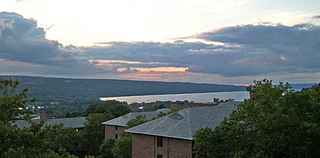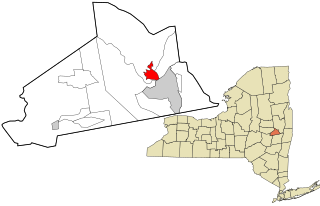
The British Isles are a group of islands in the North Atlantic off the north-western coast of continental Europe that consist of the islands of Great Britain, Ireland, the Isle of Man, the Hebrides and over six thousand smaller isles. They have a total area of about 315,159 km2 and a combined population of almost 72 million, and include two sovereign states, the Republic of Ireland, and the United Kingdom of Great Britain and Northern Ireland. The islands of Alderney, Jersey, Guernsey, and Sark, and their neighbouring smaller islands, are sometimes also taken to be part of the British Isles, even though, as islands off the coast of France, they do not form part of the archipelago.

Cayuga Lake is the longest of central New York's glacial Finger Lakes, and is the second largest in surface area and second largest in volume. It is just under 40 miles (64 km) long. Its average width is 1.7 miles (2.7 km), and it is 3.5 mi wide (5.6 km) at its widest point near Aurora. It is approximately 435 ft deep (133 m) at its deepest point.

The Isle of Man, sometimes referred to simply as Mann, is a self-governing British Crown dependency in the Irish Sea between Great Britain and Ireland. The head of state is Queen Elizabeth II, who holds the title of Lord of Mann and is represented by a lieutenant governor. Defence is the responsibility of the United Kingdom.

The Isle of Man had become separated from Britain and Ireland by 6500 BC. It appears that colonisation took place by sea sometime during the Mesolithic era. The island has been visited by various raiders and trading peoples over the years. After being settled by people from Ireland in the first millennium, the Isle of Man was converted to Christianity and then suffered raids by Vikings from Norway. After becoming subject to Norwegian suzerainty as part of the Kingdom of Mann and the Isles, the Isle of Man later became a possession of the Scottish and then the English crowns.

The Isle of Wight is a county and the largest and second-most populous island in England. It is in the English Channel, between 2 and 5 miles off the coast of Hampshire, separated by the Solent. The island has resorts that have been holiday destinations since Victorian times, and is known for its mild climate, coastal scenery, and verdant landscape of fields, downland and chines.

The Pillars of Hercules was the phrase that was applied in Antiquity to the promontories that flank the entrance to the Strait of Gibraltar. The northern Pillar, Calpe Mons, is the Rock of Gibraltar. A corresponding North African peak not being predominant, the identity of the southern Pillar, Abila Mons, has been disputed throughout history, with the two most likely candidates being Monte Hacho in Ceuta and Jebel Musa in Morocco.

Seneca the Younger(c. 4 BC – AD 65), fully Lucius Annaeus Seneca and also known simply as Seneca, was a Roman Stoic philosopher, statesman, dramatist, and—in one work—satirist of the Silver Age of Latin literature.

The Isle of Dogs is a district in East London and is in the London Borough of Tower Hamlets, and is a part of the East End. It is referred to as the Island, It is bounded on three sides by one of the largest meanders in the River Thames. The northern boundary has never been clearly or consistently defined but many accept it to be the (former) line of the West India South Dock. The name Isle of Dogs had no official status until 1987, with the creation of the Isle of Dogs Neighbourhood by Tower Hamlets London Borough Council.

Grand Island is a town located in Erie County, New York, United States. As of the 2010 census, the town's population was 20,374, representing an increase of 9.41% from the 2000 census figure. The town's name derives from the French name La Grande Île, as Grand Island is the largest island in the Niagara River and third largest in New York state. The phrase La Grande Île appears on the town seal.

Pomponius Mela, who wrote around AD 43, was the earliest Roman geographer. He was born in Tingentera and died c. AD 45.

The Crown dependencies are three island territories off the coast of Great Britain that are self-governing possessions of the Crown: the Bailiwick of Guernsey, the Bailiwick of Jersey and the Isle of Man. They do not form part of either the United Kingdom or the British Overseas Territories. Internationally, the dependencies are considered "territories for which the United Kingdom is responsible", rather than sovereign states. As a result, they are not member states of the Commonwealth of Nations. However, they do have relationships with the Commonwealth, the European Union, and other international organisations, and are members of the British–Irish Council. They have their own teams in the Commonwealth Games. They are not part of the European Union (EU), although they are within the EU's customs area. The Isle of Man is within the EU's VAT area.
The Seneca are a group of indigenous Iroquoian-speaking people native to North America who historically lived south of Lake Ontario. They were the nation located farthest to the west within the Six Nations or Iroquois League (Haudenosaunee) in New York before the American Revolution.
Little Island can refer to:

The Council of the Isles of Scilly is a sui generis unitary local government authority covering the Isles of Scilly off the west coast of Cornwall. It is currently made up of 16 seats, with all councillors being Independents as of 2 May 2013. The council was created in 1890 as the Isles of Scilly Rural District Council and was renamed in 1974.

The Church of the Good Shepherd is an Episcopal church on Saint Hubert's Isle in Raquette Lake, in the town of Long Lake, New York. Erected by developer William West Durant in 1880, it was built to serve the owners, guests and employees of the Great Camps that Durant was creating in the area. Designed by the architectural firm of J. Cleaveland Cady of New York City, Good Shepherd is an example of the stick style of architecture, popular during the latter part of the 19th century. The island was originally named Bluff Island, but was later renamed in honor of Saint Hubert, the patron saint of hunters.

The Isles of Scilly is an archipelago off the southwestern tip of Cornwall. One of the islands, St Agnes, is the most southerly point in England, being over 4 miles (6.4 km) further south than the most southerly point of the British mainland at Lizard Point.

Belle Isle Park, more commonly known simply as Belle Isle, is a 982-acre island park in the Detroit River between Michigan and Ontario. The U.S.-Canada border is in the channel south of Belle Isle such that the island is not in Canada. Owned by the city of Detroit, Belle Isle is managed as a state park by the Michigan Department of Natural Resources through a 30-year lease initiated in 2013; it was previously a city park. Belle Isle is the largest city-owned island park in the United States and is the third largest island in the Detroit River after Grosse Ile and Fighting Island. It is connected to mainland Detroit by the MacArthur Bridge.

The Caves of Hercules is an archaeological cave complex located in Cape Spartel, Morocco. Situated 14 kilometres (9 mi) west of Tangier, the popular tourist attraction is adjacent to the summer palace of the King of Morocco.



















